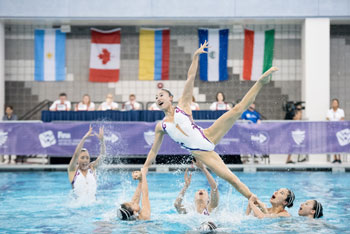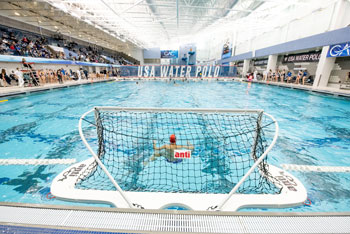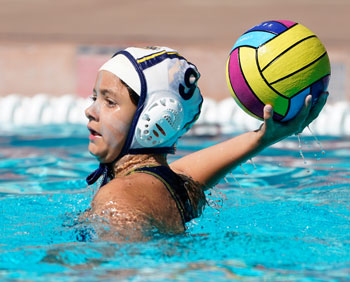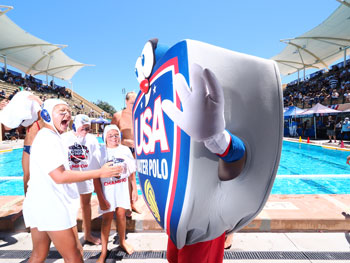Laura Voet runs the Ft. Lauderdale Parks and Recreation aquatics department in Florida. There are five community pools and the Ft. Lauderdale Aquatic Center facility, which sits next to the International Swimming Hall of Fame and boasts two 50-meter Olympic-size pools, a diving pool, a teaching pool and a spa.

The center is home to U.S. National Team champions, the Fort Lauderdale Dive Team and Swim Fort Lauderdale, an award-winning USA Swimming and U.S. Masters Swimming team. Dave Burgering, the 2008 USA Olympic diving coach, member of the 1980 USA Olympic team and past-president of USA Diving, directs the diving team at the facility.
Open 365 days a year, the aquatic complex is an active facility and hosts an average of 50 events each year. The pool’s legacy includes the Annual College Swim Forum, U.S. National Swimming Championships, YMCA National Swimming & Diving Championships, U.S. Masters National Swimming Championships, NCAA National Water Polo Championships, the FINA/U.S. International Diving Invitational, and national and international synchronized swimming competitions.
Since the building is municipal, one of its main draws is that anyone can use pools where 10 world records have been set and that still host international athletes when they train and compete.
“You could be swimming right next to them on any given day,” Voet said.
The complex just underwent a $27 million renovation and yet one of Voet’s priorities is offering the community water polo instruction because enough residents have expressed interest.
Just as competitive swimming programs need basic swimming instruction programs first, other aquatic sports like diving and artistic swimming (formerly named synchronized swimming) need facilities to offer lessons to raise awareness and increase interest and provide teams with athletes. Voet wants to offer water polo in her programming, but it’s not as simple as hiring instructors, buying equipment and making pool space available.
Her concerns are the concerns of any aquatic facility operator trying to offer more sports instruction and programming.
“It’s sort of like a puzzle trying to put it together because you don’t want to upset your swim coaches and dive coaches,” she said. “That’s the hardest part. It’s like you’re trying to maximize your space and time, and what’s the best use of this space and time.”

Mick and Sue Nelson run one of the premier facility programming consultancies in the aquatics world, and in addition to the programming tenets they call TAD—temperature, access and depth—efficiency is key to their advising goals.
“What we’re looking at is how we can effectively use each pool every minute of the day that the facility is open so that we have the most positive community influence,” said Mick Nelson. “Everyone wants to have everything; they want to have the lap swimming, the competitive swimming, the waterslide.”
Keeping all constituents satisfied is an all-day affair, but when offering more sports, the most likely times for youth participation are when a facility is at its busiest, 4 to 8 p.m. on weekdays and anytime on weekends.
Hiring water polo coaches is the least of the worries for Voet—she has three already who could do the job. The space and time are the stiffest challenges.
“You don’t wanna say, oh, we’re gonna take on water polo, but you just negatively impacted your swimming team program, you know, or you want to do artistic swimming, and you just wiped out opportunities for all these people just so a handful of people can use this space,” Voet said.
For operators who also would like to add water polo to their competitive swimming and perhaps diving offerings, USA Water Polo is at the ready to facilitate, said Joe Linehan, director of regional sport growth.
Linehan said younger kids can be encouraged to explore the sport with a version called Splashball. Specifically designed as an intro to the sport for athletes 10 and under, Splashball offers step-by-step lesson-plan-based outlines with skill cards, game cards and participant certificates, making it easy to teach and eliminate the need for an experienced coach until kids increase their skill and interest.
The game is water polo without water treading, emphasizing skill development and safety for kids as young as 5. Linehan said USA Water Polo can also help with startup costs.
“USA Water Polo has partnerships with equipment suppliers to provide low-cost caps, balls and goals for new programs and facilities,” Linehan said. “The costs would be as low as $1,000 and up to $2,500 depending on what level of programming you want to provide.

“If a facility offers Splashball, anyone can teach the program. Splashball can also be an extension of swimming lessons. If a facility offers a more competitive program, USA Water Polo can provide coaching education resources for all levels of play, from simply setting up practices to drills and skills to entering competitions. As long as a facility’s staff has the ‘want to’ factor, USA Water Polo can provide the structure for successful water polo programming.”
One way to handle the customer load for recreation, instruction, therapy and competition is to simply add pools. The Greensboro N.C. Aquatic Center grew its capabilities with a 50-meter pool in 2019, boosting a facility that also boasts a recreation and fitness pool that is separate from the existing 50-meter competition pool, which is separate from a 17-foot diving tower with springboards and platforms.
The building hosts 60 events a year, services more than 20 club teams, teaches thousands of kids to swim, and offers lifeguard and fitness classes, said David Hoover, the facility manager. It employs about 85 people, 15 full-time. Hoover said the reason for the added pool was simple: The community demanded more capacity.
“Now we do not have to force out the public or swim lessons,” said Hoover.
Hoover said the number of staff in a facility that offers everything is important, but so are the duties assigned. He oversees three full-time swimming technicians, who set and run all of the equipment for the swimming and diving and water polo meets. In addition, two event managers meet with clients and do the contracts. Finally, Hoover relies on a competitive coordinator and an operations coordinator. Their focus is programming and assigning all the lane space.
“When we have these large meets, we can have the public go to the other pool so nobody’s missing out,” he said. “The facility runs whatever event’s going on and we’re still doing our programming.”
The Nelsons have a mantra: Programming precedes design.
“I need to know what I’m going to do with the pool, when I’m going to do it, and how that affects other programs,” Sue Nelson said.
Michelle Gable, a project manager with Aquatic Design Group, said that designing flexible pool and common spaces is an important trend. “Designing spaces that can accommodate both existing and future programs that have not even been invented yet is crucial,” Gable said. “Flexible infrastructure is an investment with unlimited program, and therefore revenue, potential.”
If we start at the necessary basics that most aquatics facilities have—swim lessons—how do operators transition to competitive swimming?

A recreational pool with at least eight 25-yard lanes gives a facility the opportunity to host swim meets that support six racing lanes and two warm-up/warm-down lanes, Gable said. If a recreational pool only has one to two 25-yard lanes, a competitive swim program cannot thrive. “If there is any chance a facility will want to support competitive swim programming, an adequate number of 25-yard lanes is crucial,” she said.
In addition, having deep water—7-feet or greater—and racing platforms gives a recreational pool the opportunity to more effectively and safely offer competitive swim programming. The depths and equipment support both swim practices and swim meets, while not hindering instructional and recreational programming at all.
“In fact, lanes, deeper water and racing platforms are important elements of mid- to upper-level learn-to-swim programs,” Gable said. “As students progress in swimming, 25-yard swim lengths, treading in deep water and diving progressions are all typical learn-to-swim elements.”
Competitive swim teams typically have significant storage needs, Gable said. While participants may bring much of their own personal gear to the pool, there are many pieces of equipment that need a home at the facility as it is not practical to bring them in and out for every practice and meet.
“Whether it is specialty practice equipment, dry-land training equipment or meet equipment, adequate storage is a challenging reality of competitive swim programming,” Gable said. “Meet equipment often includes portable scoreboards and large touchpads, both of which are expensive and require careful, secure storage. In addition, adequate deck space around the pool is important for competitive swim meets.”
The circulation space around the pool needed to support coaches, timing officials, swimmers, lifeguards and spectators at a meet is significant, said Gable. As a result of storage and deck needs, many facilities determine that they can support the practice atmosphere of a competitive swim team, but not the meet atmosphere.
Multi-pool facilities have an easier transition from recreational to competitive swim programming. Aside from the common circumstance of one pool in a multi-pool facility having deep enough water to support competitive swim programming, as in the Greensboro example, there is an added benefit to your community members not participating in competitive swim programming, said Gable.
“During a meet or practice, the other pool can stay open for recreational participants,” Gable said. “Additionally, if your other pool has 25-yard lanes, during a swim meet it can support warm-up/warm-down lanes. The flexibility that multi-pool facilities bring grows exponentially when a competitive swim or another competitive aquatic sport program is included in program offerings.”

Despite the flexibility that multiple pools bring, facilities that offer recreational community programming at the same time as a competitive aquatic sport program have to be strategic with common spaces like bathrooms and locker or changing rooms. When such different programs share the same spaces, logistical challenges are a programming reality, Gable said.
“Hosting the mid- to upper-level learn-to-swim programs is the ideal way to ‘home grow’ a competitive swim program or support an existing competitive swim program brought into a facility,” Gable said. “These classes that teach all four competitive swim strokes can produce competitive swimming program participants. They segue swimming from a life skill to a sport.”
To properly support those classes and the competitive swim program, ensure the instructors chosen to teach are strong in stroke mechanics and techniques, Gable said. These instructors can even transition from the lesson program to the competitive swim program and vice versa.
“If your pool can support an adult masters swim community, you can gain participants for your youth competitive swim program,” said Gable. “Oftentimes, if a parent is a swimmer, their child will swim.”
Gable said the difficulty hiring and keeping aquatics facility staff in the past decade requires new ways to solve the problem. She suggests facilities recruit lifeguards and swim instructors who participate in swimming, water polo and artistic swimming because they provide benefits to grow recreational and competitive aquatic sport programs in a way that the average lifeguard and swim instructor applicant typically does not. Also, said Gable, recruit lifeguards and swim instructors of all ages, develop creative incentives for applicants and do not let those incentives end after an applicant is hired.
“With lifeguards continuing to be in shortage, we may see more and more that coaches for competitive aquatic sport programs are considered the lifeguard on duty during practices and competitions,” she said. “This is already commonplace at many facilities and will likely continue to trend.”
If a facility wants to offer water polo and artistic swimming, it needs to cover some basics, Gable said. Artistic swimming will be a sport for men at the 2024 Paris Olympic Games, she said, so an increase in awareness is very possible.
To offer artistic swimming in its programming and be able to host competitions, a facility needs to have 25 yards of deep water—9 feet or greater—a maximum of five lanes wide. Twenty-five meters of deep water is needed at the highest competitive level, said Gable.
Storage needs for an artistic swim program are minor in comparison to the sports of swimming and water polo, Gerber said. Portable underwater sound equipment, specialty practice equipment and dry-land training equipment are common, but in lesser quantities.
For competitions, the swim routines have time requirements, so a time clock is a necessary piece of equipment, in addition to underwater sound equipment. These items are expensive and need secure storage. Artistic swimming competition deck space needs for coaches, officials, swimmers, lifeguards and spectators are minimal in comparison to swimming and water polo.
“Unique to the sport is the use of waterproof makeup, bobby pins and Knox hair gelatin for competitions,” said Gable. “Bobby pins, stained pool plaster, and gelatin occasionally ending up on pool decks and on locker room surfaces are facility realities to prepare for when offering the program.”
Facilities that offer an artistic swimming program may be able to encourage more men to participate in a sport that has historically been considered for women, Gable said. Learn-to-swim programs can introduce swimmers to the sport by teaching the basic skills of sculling and the eggbeater kick, as well as simple figures such as the Tub and the Water Wheel.
“In addition to swimming, gymnastics and diving tend to be programs with athletes that transition more easily to the sport of artistic swimming,” said Gable.
As has been discussed, USA Water Polo is trying to increase participation with its Splashball program, but a facility needs to consider whether it has the right design before it begins the path to offering more than instructional water polo, said Gable.
Having 25 yards of deep water—7-feet or greater—gives a facility the opportunity to host competitive water polo programming; 25 meters and 30 meters of deep water are needed at the highest competitive levels. Whether the field of play utilizes wall-mounted goals or floating goals, the 25-yard course in deep water supports many ages and stages of competitive water polo programming, said Gable.
Water polo teams, like swim teams, often have significant storage needs, said Gable. Athletes rely on facility-stored balls, goals and caps for practices and games. Add to this any specialty practice equipment, dry-land training equipment and game equipment, and a facility will experience the same storage reality as competitive swimming.
Game equipment often includes portable scoreboards and shot clocks, both of which can be expensive and require careful, secure storage. Deck space needs for water polo games are less than that of competitive swim programming, but adequate space is still needed for coaches, referees, athletes, lifeguards and spectators.
As a result of depth, field of play, storage and deck needs, many facilities cannot fully host regulation water polo practices and games. If such a course is not realistic, with minimal space and shallow water—at least 3’6” to 4’6”—a facility can support Splashball water polo programming.
“You can introduce your program participants to your Splashball programming by having your mid- to upper-level learn-to-swim programs tread water, pass a water polo ball back and forth, and even have mini water polo games,” said Gable.
Regardless of what level of water polo programming is offered, said Gable, water polo balls fly around the facility, making it difficult for other aquatics programs to share a pool with water polo.
“Strategic scheduling and the use of nets across a pool can support the successful integration of water polo into a facility and its program offerings,” Gable said.
One final word of advice from the Nelsons: Offering any sport other than swimming, even popular hybrid programming phenomena such as obstacle courses and climbing walls, must not be undertaken without proper execution of the essential, basic program that teaches a life
skill, enhances water safety and
pays the bills.
“For all aquatic centers, your learn-to-swim is your basic foundation, and that’s where it all starts,” Mick said. “To create programs for retention, programs for the community, you need to have learn to swim.” RM



